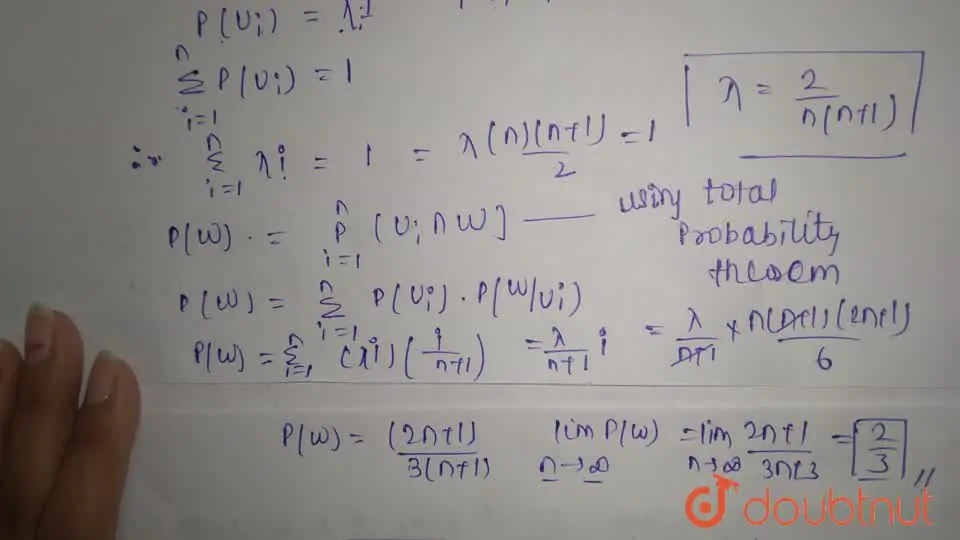There are n urns each containing (n+1) balls such that the ith urn contains ' I' white balls and (n+1-i) red balls. Let Ui be the event of selecting ith urn, i=1,2,3,.., n and W denotes the event of getting a white ball. If P(Ui)∝ i, where i=1,2,3,..,n, then limn→∞P(W) is equal to
1
23
14
34
The correct Answer is:B
We have,
P(Ui)∝I,i=1,2,..,n
⇒P(Ui)=λI,i=1,2,..,n
But, n∑i=1P(Ui)=1
∴n∑i=1λi=1⇒λn(n+1)2=1⇒λ=2n(n+1)
Now,
P(W)=nPi=1(Ui∩W) [Using Total probability Theorem]
⇒P(W)=n∑i=1P(Ui)P(W/Ui)
⇒P(W)=n∑i=1λi×in+1
⇒P(W)=λn+1nii=12=λn+1×n(n+1)(2n+1)6
⇒P(W)=2n+13(n+1)
∴limn→∞P(W)= limn→∞2n+13n+3=23
Related Playlists
- BOOK - OBJECTIVE RD SHARMA ENGLISHCHAPTER - PROBABILITY EXERCISE - Section- II (Assertion -Reason Types MCQs)15videos
PROBABILITY
- BOOK - OBJECTIVE RD SHARMA ENGLISHCHAPTER - PROBABILITY EXERCISE - Section I - Mcqs89videos
PROBABILITY
- BOOK - OBJECTIVE RD SHARMA ENGLISHCHAPTER - PROBABILITY EXERCISE - Chapter Test45videos
PROBABILITY
- BOOK - OBJECTIVE RD SHARMA ENGLISHCHAPTER - PERMUTATIONS AND COMBINATIONSEXERCISE - Chapter Test60videos
PERMUTATIONS AND COMBINATIONS
- BOOK - OBJECTIVE RD SHARMA ENGLISHCHAPTER - QUADRATIC EXPRESSIONS AND EQUATIONS EXERCISE - Chapter Test50videos
QUADRATIC EXPRESSIONS AND EQUATIONS
Similar Questions
There are n urns each containing (n+1) balls such that ith urn contains i white balls and (n+1-i) red balls. Let u_i be the event of selecting ith urn, i=1,2,3…, n and w denotes the event of getting a white ball. IfP(u_i)=c, where c is a constant then P(u_n/w) is equal to
View SolutionIn Example 94, if P(Ui)=C, where C is a constant, then P(Un/W) is equal to
View SolutionIf i=√−1, then (in+i−n,n∈Z) is equal to
View SolutionIf i=√−1, then (in+i−n,n∈Z) is equal to
View SolutionIn Example 94, if n is even and E denotes the event of choosing even numbered urn (p(Ui)=1n), then the value of P(W/E), is
View SolutionThere are 4 urns. The first urn contains 1 white and 1 black ball, the second um contains 2 white and 3 black balls, the third urn contains 3 white and 5 black balls & the fourth urn contains 4 white & 7 black balls. The selection of each um is not equally likely. The probability of selecting ithurn is i2+134(i=1,2,3,4). If we randomly select one of the urns & draw a ball, then the probability of ball being white is: 5691496 (b) 2756 (c) 873 (d) None of these
View SolutionThere are 4 urns. The first urn contains 1 white and 1 black ball, the second um contains 2 white and 3 black balls, the third urn contains 3 white and 5 black balls & the fourth urn contains 4 white & 7 black balls. The selection of each um is not equally likely. The probability of selecting ithum is i2+134(i=1,2,3,4). If we randomly select one of the urns & draw a ball, then the probability of ball being white is:
(a)5691496 (b) 2756
(c) 873 (d) None of theseView Solutionn∑i=1n∑i=1i is equal to
View SolutionTwo balls drawn from an urn containing 2 white, 3 red and 4 black balls. What is the probability that the ball is red?
View SolutionEach of the n urns contains 4 white and 6 black balls. The (n+1) th urn contains 5 white and 5 black balls. One of the n+1 urns is chosen at random and two balls are drawn from it without replacement. Both the balls turn out to be black. If the probability that the (n+1) th urn was chosen to draw the balls is 1/16, then find the value of n .
View Solution


